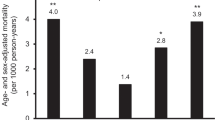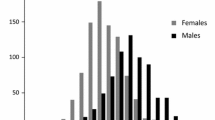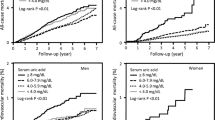Abstract
Objectives
High levels of serum uric acid (UA) are associated with cerebro-cardiovascular disease risk factors. This study aimed at evaluating the main determinants of serum UA levels in relation to biochemical, lifestyle, and clinical variables.
Methods
The study population included 15,594 participants (48% men, age ≥ 35 years) to the Moli-sani Study, for whom data on serum UA levels were available. Association of UA with dependent variables was investigated by multivariable linear regression analysis separately for men and women.
Results
Average serum UA levels were higher in men than in women (6.1 ± 1.3 vs 4.6 ± 1.2 mg/dL, respectively). Cystatin C, creatinine, albumin, triglycerides, body mass index (BMI), and diuretic therapy were the major determinants of the heterogeneity of UA levels. In women, the final model, resulting from the stepwise analysis, explained 41.6% of the UA variability. In particular, cystatin C explained 22.5% of UA variance, followed by BMI (7.2%), albumin (4.0%), and creatinine (1.9%). The final model in men fitted the data less than in women (total R2 = 29.1%), and creatinine was found to be the main determinant of UA levels (10.1%), followed by triglycerides (7.6%), BMI (3.7%), and albumin (2.0%).
Conclusions
In a general adult population, the major determinants of serum UA levels are cystatin C, creatinine, BMI, triglycerides, albumin, and the use of diuretics. Knowledge of its main determinants will be useful to better evaluate the relationship between UA levels and detrimental health outcomes and to clarify if an increase in uricemia is a marker or an independent risk factor.
Key Points • Increased serum uric acid (UA) levels are reportedly associated with cardiovascular disease risk factors. • The major determinants of heterogeneity of UA levels are cystatin C, creatinine, BMI, triglycerides, albumin, and the use of diuretics, in a general adult population. • Studying the main determinants associated with high levels of serum uric acid would help better understanding if uric acid is a marker or an independent cardiovascular risk factor. |


Similar content being viewed by others
References
Glantzounis GK, Tsimoyiannis EC, Kappas AM, Galaris DA (2005) Uric acid and oxidative stress. Curr Pharm Des 11(32):4145–4151
Lippi G, Montagnana M, Franchini M, Favaloro EJ, Targher G (2008) The paradoxical relationship between serum uric acid and cardiovascular disease. Clin Chim Acta 392(1-2):1–7
Doehner W, Landmesser U (2011) Xanthine oxidase and uric acid in cardiovascular disease: clinical impact and therapeutic options. SeminNephrol 31(5):433–440
Brand FN, McGee DL, Kannel WB, Stokes J 3rd, Castelli WP (1985) Hyperuricemia as a risk factor of coronary heart disease: the Framingham Study. Am J Epidemiol 121(1):11–18
Bonora E, Targher G, Zenere MB, Saggiani F, Cacciatori V, Tosi F et al (1996) Relationship of uric acid concentration to cardiovascular risk factors in young men. Role of obesity and central fat distribution. The Verona Young Men Atherosclerosis Risk Factors Study. Int J Obes Relat Metab Disord 20(11):975–980
Rathmann W, Funkhouser E, Dyer AR, Roseman JM (1998) Relations of hyperuricemia with the various components of the insulin resistance syndrome in young black and white adults: the CARDIA study, Coronary Artery Risk Development in Young Adults. Ann Epidemiol 8(4):250–261
Gustafsson D, Unwin R (2013) The pathophysiology of hyperuricaemia and its possible relationship to cardiovascular disease, morbidity and mortality. BMC Nephrol 14:164
Di Castelnuovo A, Costanzo S, Persichillo M, Olivieri M, de Curtis A, Zito F et al (2012) MOLI-SANI Project Investigators, Distribution of short and lifetime risks for cardiovascular disease in Italians. Eur J PrevCardiol 19(4):723–730
Iacoviello L, De Curtis A, Donati MB, de Gaetano G (2014) Biobanks for cardiovascular epidemiology and prevention. Futur Cardiol 10(2):243–254
Zeller T, Hughes M, Tuovinen T, Schillert A, Conrads-Frank A, Ruijter HD et al (2014) BiomarCaRE: rationale and design of the European BiomarCaRE project including 300,000 participants from 13 European countries. Eur J Epidemiol 29(10):777–790
Pounis G, Bonaccio M, Di Castelnuovo A, Costanzo S, de Curtis A, Persichillo M et al (2016) Polyphenol intake is associated with low-grade inflammation, using a novel data analysis from the Moli-sani Study. Thromb Haemost 115(2):344–352
Bonaccio M, Di Castelnuovo A, Costanzo S, Persichillo M, De Curtis A, Donati MB et al (2016) MOLI-SANI Study Investigators, Adherence to the traditional Mediterranean diet and mortality in subjects with diabetes. Prospective results from the MOLI-SANI Study. Eur J Prev Cardiol 23(4):400–407
Costanzo S, Mukamal KJ, Di Castelnuovo A, Bonaccio M, Olivieri M, Persichillo M et al (2019) Moli-sani Study Investigators, Alcohol consumption and hospitalization burden in an adult Italian population: prospective results from the Moli-sani Study. Addiction 114(4):636–650
Richette P, Doherty M, Pascual E, Barskova V, BecceF C-SJ et al (2017) 2016 updated EULAR evidence-based recommendations for the management of gout. Ann Rheum Dis 76(1):29–42
Kubo S, Nishida Y, Kubota Y, Higashiyama A, Sugiyama D, Hirata T, Miyamatsu N, Tanabe A, Hirata A, Tatsumi Y, Kadota A, Kuwabara K, Nishikawa T, Miyamoto Y, Okamura T (2019) Higher serum uric acid level is inversely associated with renal function assessed by cystatin C in a Japanese general population without chronic kidney disease: the KOBE study. BMC Nephrol 20(1):117
Iseki K, Ikemiya Y, Inoue T, Iseki C, Kinjo K, Takishita S (2004) Significance of hyperuricemia as a risk factor for developing ESRD in a screened cohort. Am J Kidney Dis 44(4):642–650
Grubb AO (2000) Cystatin C--properties and use as diagnostic marker. Adv Clin Chem 35:63–99
Matsuura F, Yamashita S, Nakamura T, Nishida M, Nozaki S, Funahashi T, Matsuzawa Y (1998) Effect of visceral fat accumulation on uric acid metabolism in male obese subjects: visceral fat obesity is linked more closely to overproduction of uric acid than subcutaneous fat obesity. Metabolism 47(8):929–933
Fox IH (1981) Metabolic basis for disorders of purine nucleotide degradation. Metabolism 30(6):616–634
Fabregat I, Revilla E, Machado A (1987) Short-term control of the pentose phosphate cycle by insulin could be modulated by the NADPH/NADP ratio in rat adipocytes and hepatocytes. Biochem Biophys Res Commun 146(2):920–925
Whitworth DA, Ratledge C (1975) An analysis of intermediary metabolism and its control in a fat-synthesizing yeast (Candida 107) growing on glucose or alkanes. J Gen Microbiol 88(2):275–288
Savage PJ, Pressel SL, Curb JD, Schron EB, Applegate WB, Black HR, Cohen J, Davis BR, Frost P, Smith W, Gonzalez N, Guthrie GP, Oberman A, Rutan G, Probstfield JL, Stamler J (1998) Influence of long-term, low-dose, diuretic-based, antihypertensive therapy on glucose, lipid, uric acid, and potassium levels in older men and women with isolated systolic hypertension: the Systolic Hypertension in the Elderly Program. SHEP Cooperative Research Group. Arch Intern Med 158(7):741–751
Ames BN, Cathcart R, Schwiers E, Hochstein P (1981) Uric acid provides an antioxidant defense in humans against oxidant- and radical-caused aging and cancer: a hypothesis. Proc Natl Acad Sci U S A 78(11):6858–6862
Gersch C, Palii SP, Kim KM, Angerhofer A, Johnson RJ, Henderson GN (2008) Inactivation of nitric oxide by uric acid. Nucleosides Nucleotides Nucleic Acids 27(8):967–978
Wayner DD, Burton GW, Ingold KU, Locke S (1985) Quantitative measurement of the total, peroxyl radical-trapping antioxidant capability of human blood plasma by controlled peroxidation. The important contribution made by plasma proteins. FEBS Lett 187(1):33–37
Halliwell B (1988) Albumin: an important extracellular antioxidant? Biochem Pharmacol 37(4):569–571
Su Z, Chen Z, Xiang Y, Wang B, Huang Y, Yang D, Li X, Weng Y, Lin XF, Chen G, Liu W, Zhao C, Wang Q, Li S, Chen Y, Chen Y, Quan W, Tong Q, Wu S, Huang S, Mei P, Li Z, Li J, Hou S, Zhang X (2017) Low serum levels of uric acid and albumin in patients with Guillain-Barre syndrome. Medicine (Baltimore) 96(25):e6618
Yang D, Su Z, Wu S, Bi Y, Li X, Li J, Lou K, Zhang H, Zhang X (2016) Low antioxidant status of serum bilirubin, uric acid, albumin and creatinine in patients with myasthenia gravis. Int J Neurosci 126(12):1120–1126
Wang H, Wang L, Xie R, Dai W, Gao C, Shen P, Huang X, Zhang F, Yang X, Ji G (2014) Association of Serum Uric Acid with body mass index: a cross-sectional Study from Jiangsu Province, China. Iran J Public Health 43(11):1503–1509
Yamashita S, Matsuzawa Y, Tokunaga K, Fujioka S, Tarui S (1986) Studies on the impaired metabolism of uric acid in obese subjects: marked reduction of renal urate excretion and its improvement by a low-calorie diet. Int J Obes 10(4):255–264
Tsushima Y, Nishizawa H, Tochino Y, Nakatsuji H, Sekimoto R, Nagao Het al (2013) Uric acid secretion from adipose tissue and its increase in obesity. J BiolChem 288(38):27138–27149
Bengtsson C (1979) Elevated serum uric acid levels during treatment with antihypertensive drugs. Acta Med Scand Suppl 628:69–71
Ayvazian JH, Ayvazian LF (1961) A study of the hyperuricemia induced by hydrochlorothiazide and acetazolamide separately and in combination. J Clin Invest 40:1961–1966
Steele TH, Oppenheimer S (1969) Factors affecting urate excretion following diuretic administration in man. Am J Med 47(4):564–574
Ames BN, Cathcart R, Schwiers E, Hochstein P (1981) Uric acid provides an antioxidant defence in humans against oxidant- and radical-caused aging and cancer: a hypothesis. Proc Natl Acad Sci U S A 78(11):6858–6862
Acknowledgments
The Moli-sani research group thanks the Associazione Cuore Sano Onlus (Campobasso, Italy) for its financial and cultural support.
Funding
The present analyses were partially supported by a grant from Menarini Spa.
The enrolment phase of the Moli-sani Study was supported by research grants from the Pfizer Foundation (Rome, Italy), the Italian Ministry of University and Research (MIUR, Rome, Italy)–Programma Triennale di Ricerca, Decreto no.1588 and Instrumentation Laboratory, Milan, Italy.
Laboratory analyses of the Moli-sani Study were partially supported by: Werfen Instrumentation Laboratory Spa, Milan, Italy; BiomarCaRE (Biomarkers for Cardiovascular Risk Assessment in Europe): European Commission Seventh Framework Programme FP7/2007–2013 (HEALTH-F2-2011-278913) (L.I.); the Italian Ministry of Health, Grant 2018 (PI G.d.G, CoPI S.C., number grant: RF-2018-12367074).
Author information
Authors and Affiliations
Consortia
Contributions
M.B.D, L.I., S.M., and S.C. contributed to the concept and design of the work and interpretation of data; S.C., A.De.C., and M.O. managed data collection; S.C. analyzed the data and reviewed the manuscript; S.M. wrote the paper; M.B.D., C.C., G.d.G., A.Di.C., and L.I. originally inspired the research and critically reviewed the manuscript.
Corresponding author
Ethics declarations
The Moli-sani Study complies with the Declaration of Helsinki and was approved by the Catholic University ethical committee, Rome, Italy. All participants provided written informed consent.
Disclaimer
Funders had no role in study design; collection, analysis, or interpretation of data; the writing of the manuscript; or the decision to submit the article for publication.
Conflict of interest
None.
Additional information
Publisher’s note
Springer Nature remains neutral with regard to jurisdictional claims in published maps and institutional affiliations.
Moli-sani Study Investigators are listed in the Supplementary file, Appendix S1.
Electronic supplementary material
ESM 1
(DOCX 695 kb)
Rights and permissions
About this article
Cite this article
Magnacca, S., Costanzo, S., De Curtis, A. et al. Determinants of serum uric acid levels in an adult general population: results from the Moli-sani Study. Clin Rheumatol 40, 857–865 (2021). https://doi.org/10.1007/s10067-020-05288-w
Received:
Revised:
Accepted:
Published:
Issue Date:
DOI: https://doi.org/10.1007/s10067-020-05288-w




